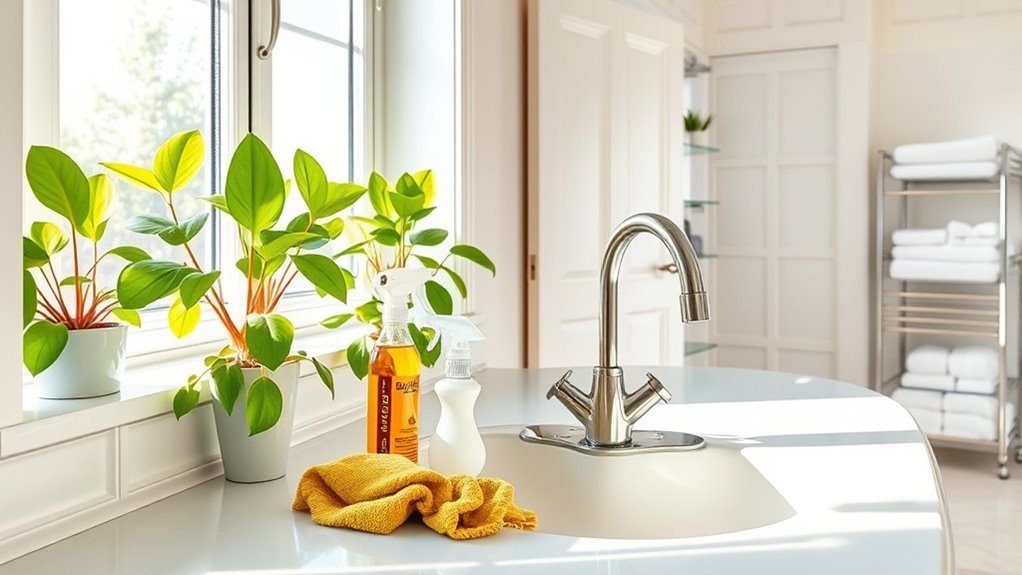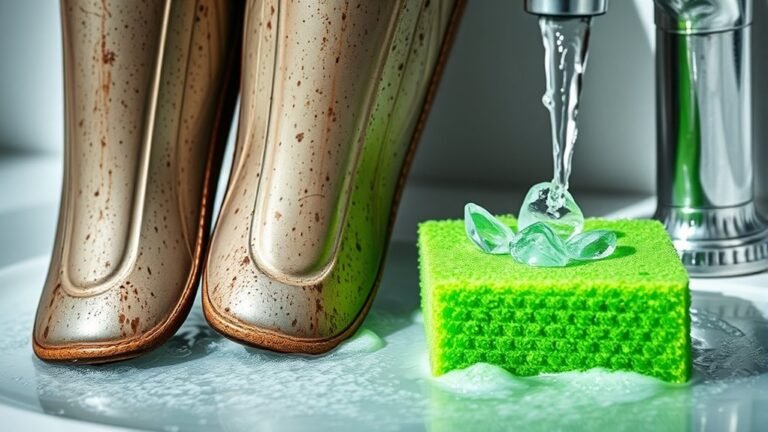Cleaning Tips for Homes in High-Humidity Climates
In high-humidity homes, controlling moisture is key to preventing mold and odors. You’ll want to use mold-resistant cleaners, wipe wet surfaces promptly, and guarantee your kitchen and bathroom vents work well. Open windows for cross-ventilation when possible, and place dehumidifiers centrally to keep air dry. Protect wood and fabrics by allowing airflow and avoiding damp spots. Consistent upkeep helps keep your space fresh and damage-free. There’s plenty more to learn about maintaining a comfortable, healthy home in humid climates.
Understanding the Impact of Humidity on Your Home

Although humidity is a natural part of the environment, high levels inside your home can cause various problems. You might notice musty odors, condensation on windows, or even mold growth—all signs of excessive moisture. Understanding humidity effects is key to maintaining a fresh, comfortable living space where you feel free and unburdened. Moisture sources like cooking, showering, and even breathing add to indoor humidity. Without proper attention, this trapped moisture can damage walls, furniture, and your health. Recognizing how these factors impact your home empowers you to take control, preventing discomfort and decay. By staying aware of humidity effects and moisture sources, you can keep your home a haven, not a hassle, ensuring it remains a place where you truly feel free.
Effective Ventilation Strategies to Reduce Moisture
When you improve ventilation in your home, you actively reduce excess moisture that contributes to humidity problems. Start by installing window fans to boost airflow—these let fresh air in and push damp air out, giving your space instant relief. Make sure exhaust vents in bathrooms and kitchens are working efficiently; they’re your best defense against trapped moisture from showers and cooking. Keep vents clean and unobstructed to maintain maximum performance. You can also create cross-ventilation by opening windows on opposite sides of a room, encouraging a natural breeze to carry humidity away. Taking control of airflow not only lowers moisture but also gives you freedom from mold and musty odors, making your home a healthier, more comfortable place to be.
Choosing the Right Cleaning Products for Humid Environments

When cleaning in high-humidity areas, you’ll want products that resist mold growth to keep surfaces fresh longer. Look for solutions with moisture-absorbing ingredients to help control dampness. Choosing the right cleaners can make a big difference in preventing mildew and maintaining a healthier home.
Mold-Resistant Cleaning Solutions
Since high humidity creates the perfect environment for mold to thrive, choosing the right cleaning products is essential to keep your home safe and fresh. You want mold-resistant cleaning solutions that work effectively without trapping you in harsh chemicals. Natural disinfectants like tea tree oil or vinegar are powerful yet gentle options, offering protection while respecting your desire for eco friendly solutions. These ingredients not only clean but help prevent mold growth, giving you peace of mind without compromising your freedom to choose safer products. Avoid cleaners with strong synthetic chemicals; instead, opt for those labeled mold-resistant and biodegradable. By selecting the right products, you maintain a healthy, mold-free space that aligns with your values and keeps your high-humidity home comfortable.
Moisture-Absorbing Ingredients
Three moisture-absorbing ingredients you’ll often find in cleaning products designed for humid environments are silica gel, activated charcoal, and calcium chloride. These desiccant materials excel at moisture control, helping keep your living space dry and fresh. Choosing products with these ingredients means you’re actively fighting excess humidity, preventing mold and mildew growth. Here’s a quick guide to help you pick the right moisture-absorbing agent:
| Ingredient | Moisture Control Level | Best Use Case |
|---|---|---|
| Silica Gel | Moderate | Small spaces, closets |
| Activated Charcoal | Moderate | Odor control + moisture |
| Calcium Chloride | High | Large rooms, basements |
| Clay Desiccants | Low | Decorative, mild control |
| Zeolite | Moderate | Air purification + drying |
Selecting effective desiccant materials frees you from dampness worries, making your home comfortable and healthy.
Preventing Mold and Mildew Growth in Key Areas
Although high humidity can make your home feel uncomfortable, it also creates the perfect environment for mold and mildew to thrive, especially in hidden or damp spots. To protect your space, you’ll want to focus on effective mold prevention techniques. Start by using mildew resistant materials in areas prone to moisture, like basements or closets. These materials help reduce the chance of growth without constant upkeep. Make sure to keep airflow steady and dry wet surfaces quickly. You can also seal cracks and gaps where moisture sneaks in. By staying proactive with these strategies, you maintain a healthier home and keep mold’s grip at bay. Taking control means more freedom to enjoy your space without worrying about unseen damage or musty odors.
Regular Maintenance Tips for Bathrooms and Kitchens

To keep mold from taking hold in your bathroom and kitchen, regular maintenance is key. Make sure you’re using proper ventilation, like exhaust fans or open windows, to reduce moisture buildup. Staying on top of these habits will help you maintain a cleaner, healthier space.
Prevent Mold Growth
Since bathrooms and kitchens are hotspots for moisture, keeping them dry is key to preventing mold growth. Different mold types thrive in damp conditions, so mold prevention starts with regular care. You can take control and keep your space fresh by:
- Wiping down wet surfaces immediately after use.
- Fixing leaks or drips promptly to avoid hidden moisture.
- Using mold-resistant products like paints and sealants.
- Cleaning grout and corners weekly to remove mold spores early.
Ventilation Best Practices
When you want to keep moisture—and the problems it brings—under control, proper ventilation in bathrooms and kitchens is essential. You can rely on natural ventilation by opening windows and doors whenever possible to boost fresh air flow. This simple habit enhances air circulation, helping to prevent mold and mildew buildup. Also, make sure your exhaust fans are clean and working efficiently; they’re your best defense against trapped humidity. Regularly check vents for blockages and replace filters as needed. By staying consistent with these ventilation best practices, you’ll create a healthier, fresher space that feels free and comfortable. Remember, good air movement isn’t just about comfort—it’s about protecting your home and your peace of mind in a high-humidity climate.
How to Manage Musty Odors Naturally
Although musty odors can be stubborn in high-humidity homes, you can tackle them effectively using natural methods. Embrace natural deodorizing techniques to reclaim your space’s freshness without harsh chemicals. Here’s how you can do it:
Musty odors in humid homes can be banished naturally, restoring freshness without harsh chemicals.
- Open windows daily to let fresh air circulate and push out stale smells.
- Use baking soda in carpets and upholstery; leave it for hours, then vacuum to absorb odors.
- Create a spray with water and a few drops of essential oils like lavender or eucalyptus; mist rooms lightly.
- Place bowls of white vinegar around problem areas overnight to neutralize lingering odors.
These simple steps help you breathe easy and maintain a home that feels open and free—just the way you want it.
Protecting Wooden and Fabric Surfaces From Moisture Damage
Because high humidity can quickly ruin wooden and fabric surfaces, you’ll want to take proactive steps to protect them from moisture damage. Start with wood preservation by applying a quality sealant or wood oil to create a moisture barrier. Keep wooden furniture and floors dry by wiping spills immediately and using coasters or mats. For fabric protection, choose moisture-resistant covers and wash textiles regularly to prevent mold and mildew. Avoid placing wooden or fabric items directly against damp walls or floors, and allow proper airflow around them to reduce trapped moisture. By maintaining these habits, you’ll extend the life of your belongings and keep your space feeling fresh and free from the constraints of humidity-related damage.
Utilizing Dehumidifiers and Air Purifiers Effectively
Protecting your wooden and fabric surfaces is just one part of managing humidity in your home. To truly free your space from dampness and allergens, you’ll want to use your dehumidifier and air purifier smartly. Here’s how:
- Optimize dehumidifier placement—position it centrally in the most humid room, away from walls, for better airflow.
- Set your air purifier settings to a medium or high level during peak humidity times to capture mold spores and dust.
- Keep doors and windows closed while running these devices to maintain controlled air quality.
- Regularly clean or replace filters to guarantee peak performance.
Mastering these steps will help you reclaim a fresher, drier home where you’re free to breathe easy and live comfortably.
Seasonal Cleaning Routines for High-Humidity Homes
When humidity levels rise with the seasons, your cleaning routine needs to adapt to prevent mold, mildew, and dust buildup. Embrace seasonal deep cleaning as your freedom tool—focus on areas prone to moisture like basements, bathrooms, and window sills. Wipe down surfaces with mold-fighting solutions and wash fabrics that trap humidity, like curtains and cushions. Don’t forget to vacuum vents and clean behind appliances to eliminate hidden dampness.
Effective humidity management means pairing your cleaning routine with dehumidifiers and good ventilation. Regularly check for leaks and fix them promptly to keep moisture out. By staying proactive with seasonal deep cleaning, you’re not just maintaining your home—you’re reclaiming your space from humidity’s grip and enjoying a fresher, freer living environment year-round.
Frequently Asked Questions
Can Houseplants Help Reduce Indoor Humidity Levels?
Did you know some houseplants can absorb up to 97% of indoor humidity? When it comes to reducing indoor moisture, your houseplant selection matters a lot. Plants like Boston ferns and peace lilies naturally soak up humidity, helping you feel freer from sticky air and mold worries. By choosing the right greenery, you’re not just decorating—you’re creating a more comfortable, breathable space where you can truly relax and enjoy your home.
How Often Should HVAC Filters Be Replaced in Humid Climates?
You should replace your HVAC filters every 30 to 60 days in humid climates to keep things running smoothly. Different filter types, like fiberglass or pleated, handle moisture differently, so pick one that suits your needs. Regular HVAC maintenance tips include checking filters often and changing them promptly to prevent mold and improve air quality. Staying on top of this gives you freedom from costly repairs and keeps your home comfy.
Are There Specific Types of Flooring Better Suited for High Humidity?
Oh sure, you just want your floors to soak up water and invite mold, right? Actually, you’ll want water resistant materials like vinyl, tile, or sealed concrete—they laugh in the face of humidity. These options cut down on flooring maintenance, giving you freedom from constant repairs and worry. So go ahead, pick smart flooring that handles moisture like a champ, freeing you to enjoy your space without stress.
What Are the Signs of Hidden Water Damage Behind Walls?
You’ll want to watch for water stains that look like discoloration or bubbling paint on your walls—it’s a big clue something’s wrong. Mold growth, often black or green spots, is another telltale sign hidden behind walls. You might also notice a musty smell or warped drywall. Trust your instincts; if anything feels off, don’t hesitate to investigate further and reclaim control over your living space.
Can Using a Humidifier Worsen Mold Problems in Humid Areas?
They say, “Don’t add fuel to the fire,” and when it comes to humidifier effectiveness, that’s spot on. If you’re in a naturally humid area, using a humidifier without careful control can actually worsen mold problems. You want to prevent mold by keeping moisture levels balanced, not boosting them. So, while humidifiers help in dry conditions, in high humidity, they might undermine your mold prevention efforts and trap you in a cycle.






